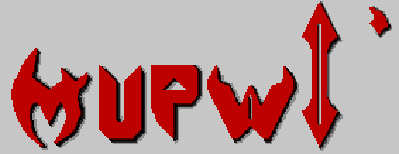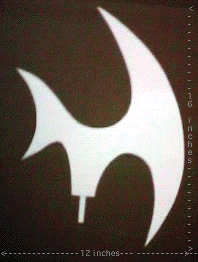


I welcome all of you who appreciate the seductive curves and radiant warmth of steel fashioned into the perfect Klingon blade - the betleH vaQqu' !! Whether you are fortunate enough to create your own custom weapons, aspire to learn the art or just want to associate with blade-smiths, *The Guild* is here to serve you and the Empire.
This month we have a couple of new sections that I think you will enjoy and hopefully become enthusiastic about. Be sure to provide me with any feedback on this or any other issue and also any ideas for sections you'd like to see in the *mupwI'*.
K'Beck has provided us with a *historical* account of the development of the meqleth which will appear later in this letter . K'Beck has also agreed to *persuade* his contacts in the Klingon Bureau of Information to provide us with the histories of as many of the edged weapons as they can. We will also start a series that takes us through one craftsman's routine for designing and producing an authentic *new* Klingon weapon.
mupwI' yI'uchtaH !! (Keep holding the hammer ! )
K'Daq son of Toragh
Master of the Heart of Kri'stak

This month's letter to the editor has been developed into a new section.......the Blade Histories section. This will be the responsibility of K'Beck and as you will see, he has done a good job on the first installment. If any of you have an interesting history tied to the development of a weapon, please send it on to K'Beck or myself to be included in future issues.
K'Daq

As the Guild grows, we will try to enhance camaraderie by publishing histories of our members (both Klingon and Terran). It is not necessary to develop a family history to be a Guild member, but it does help to solidify an image of you as a fellow crafts person and Klin.
K'Beck writes.......I am from a Romulan prison camp. My Mother (whose name I have promised to keep secret) was captured in the attack on Khitomer and after taking a Romulan mate in the prison camp, I was the result of their union.I was returned to Qo'noS with several others by Worf. Now I am learning the culture of my home world. My father was against this and I will never reveal his name either so as to protect his house on Romulas. I presently have no house that I can claim, perhaps the house of Toragh will find me worthy? Or perhaps the House SaqIm?
K'Beck you are more than worthy - there is always a place for you in the House of Toragh if you desire it.
Next month: K'moghjIH

An excellent account of the ingenious nature of the warrior. Gowron himself has said that a Klingon can always find a weapon. As for pictures, just attach the file to your next e-mail and I'll get it up on the weapons site. I think it would be a great help in letting others see how the Klingon warrior thinks.
As for my doctor......HAHAHAHAHAHAHA..........she has tried SOOO hard to cure me..........I just felt she deserved an honorable death before I go to the Black Fleet. I look forward to your next installment.
K'Daq

There is not much to add to K'Beck's accounting. The meqleH saw a lot of action on DS9 shortly after Worf transferred there. Its a much more practical weapon for him to carry - owing to its size. As the great blade master HetaQ has said " You should never allow a weapon to give you a false sense of security". A weapon should be an extension of your natural fighting ability. Worf proves this with his fluid use of the small but powerful meqleH.
Once again I used quarter inch stainless for the weapon because of the *strength* and solid feel it gives the blade. The main blade is beveled along it's entire perimeter. The blocking blade or guard is beveled on the tip but is left rounded along its lower edge - and obviously rounded on it's inner edge.
Rather than wrap leather strips around a flat handle, I created a hidden tang and formed the handle from leather washers that were *hardened* and shaped. (see this month's tip section) This allows for a custom forming of the grip and a very comfortable weapon to hold. The pommel is half inch stainless threaded , shaped and screwed to the end of the hidden tang.


In medieval times leather was soaked in carnauba wax (a very hard substance) and this produce a material that was (while hot) supple and moldable. After it cooled the material was incredibly strong, hard and resistant to weapons attacks. This was the basis for early armor plate.
To create a hardened leather handle it is best to start with a hidden tang. You want a good thickness of leather to surround the tang (at least .25 inches) but you also want as much strength from the steel as possible. You cut out a number of leather *washers* and punch holes in the center of them that correspond to your tang's cross section. These washers can be oval (to approximate your final handle cross-section) or you can leave them rectangular. You're going to be trimming the final handle to custom shape it and I find that it is creates more work if you try to pre-cut the washers to final shape. If you cut rectangles you can lay it out on a band saw and knock out several dozen in a few minutes. The tang can be threaded for a pommel to be placed or you can use a pinned on pommel, whichever method you are used to. The threaded pommel does have one advantage in that it allows you to compress the leather washers one final time and get an even denser handle.
I usually fit a steel or horn guard to the junction of the tang and blade to act as a base for the leather and then I use 2-ton epoxy to secure the washers. This epoxy is water proof and has a long setting time so you can easily place all the washers in one sitting. After the last one is on, screw your pommel on tight (or pin it) and set it aside to harden. When the epoxy has hardened, roughly grind the leather to shape just like you would any other handle material. Come close to the final shape but do not grind to the final shape. Allow yourself a sixteenth of an inch or so.
Now get a can of lacquer and warm it up. Lacquer is flammable, so take care how you perform this step. I live in Houston and I usually just set the can on the driveway in the sunshine (or on the slopes of Kri'stak if I'm visiting
If you have carnauba wax and want to substitute it for the lacquer, go for it. Let me know how it comes out.
I hope you have as much success with this as I have. Qapla'!
The first step in producing a weapon is to have good reference material. Many pictures from books, movies or series episodes are essential. In this case we are going to invent a new weapon and therefore no such material will be available. The first step (and the subject of this installment) will be to design our own weapon using elements common to Klingon weapons.
The Mok'bara or Klingon fighting style requires weapons that have a certain *flowing* quality to them. In all of the blades seen there is always a scimitar like shape. You rarely see straight edges accept in small knives.
In a study of similar cultures who used edged weapons there is always an axe or axe-like implement. The feudal Japanese who the Klingons are most often compared to used several types of axes for tools and for weapons. With the right type of design, this style of weapon could be quite formidable in the hands of an accomplished Klingon Warrior.According to Okrand the traditional Klingon warrior's arsenal included the ax, an implement with heavy, flattened blade mounted crosswise at the end of a handle. The general term for ax is 'obmaQ. Its handle is its DeS and its blade is its ghIt. (Okrand's Klingon for the Galactic Traveler)
For the primary blade I chose a shape similar to the bat'leth's main blade. The sweeping arch will enhance the natural moves of the Mok'bara. In order to keep the weight of the weapon down the blade itself was given a thin profile and this portion of the axe is offset to place the cutting edge of the blade in the same alignment as the bat'leth's main blade when held in one hand.
The secondary or rear element of the axe uses the ancient lines of the Sword of Kahless. I felt this design element would lend itself to the fact that this was an ancient weapon of the *pre-space* Klingon Empire and would qualify as an *heirloom* weapon. It creates a large blocking element at the head of the shaft and a smaller one directly behind the center of gravity of the main blade and shaft. This rear element also provides a very destructive blade for counter-strikes.
The blade will be secured to it's handle (DeS) by resting it in a quarter inch slot with the added stabilization of a short partial tang made with a quarter inch extension of the blade pattern. The entire blade assembly will be pinned and then decoratively wrapped in the final steps.
Next month we'll talk about choosing the material for the handle or DeS and how to *dress* it up to honor our heirloom weapon and create a true 'alngegh vaQqu' !!
Remember to write with any material you'd like to have discussed or placed in
*mupwI'* ..
mupwI' yI'uchtaH !!
K'Daq

Klingon Battleaxe or 'alngegh
(from Okrand's Klingon for the Galactic Traveler)
In this issue we will be starting a series in which we go through all the steps in designing and producing an authentic Klingon style weapon.
The combination of the single axe blade with a secondary blade or spike at the end is called a 'alngegh while a two bladed axe is referred to as a jey'naS (Okrand's Klingon for the Galactic Traveler)

ghIt (Blade)

KIWG Main menu